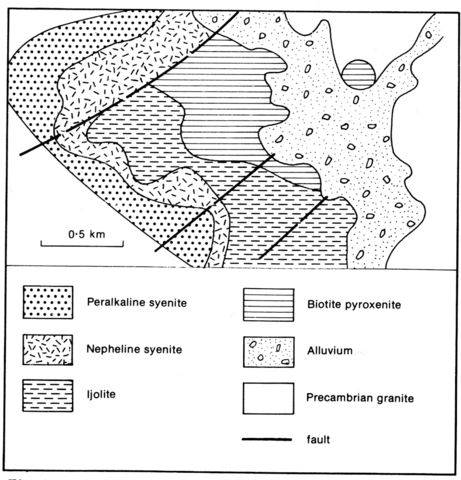stripes
Anitapolis is a partially zoned intrusion of 5 km2, the emplacement of which produced a system of radial and concentric fractures in the surrounding Precambrian granites. The granites were fenitized with development of sodic pyroxene and amphibole, particularly along fractures, and pass inwards from quartz-bearing to quartz-free syenites. The intrusive complex consists of ijolites, biotite pyroxenite, nepheline syenite and carbonatite. The ijolites are variable in composition, passing into urtites. Intimately associated with the pyroxenites, which contain 52-62% pyroxene and 30-44% biotite, are glimmerites. Carbonatite forms a discrete area in the north of the complex, but is also present as dykes and veins: it is sovite with phlogopite, magnetite, apatite, amphibole and serpentinized olivine. An analysis of the carbonatite is given by Carraro et al. (1967, p. 16).
AMARAL, G., BUSHEE, J., CORDANI, U.G., KAWASHITA, K. and REYNOLDS, J.H. 1967. Potassium-argon ages of alkaline rocks from southern Brazil. Geochimica et Cosmochimica Acta, 31: 117-42.
CARRARO, C.C., ISSLER, R.S. and FORMOSO, M.L.L. 1967. Mapeamento do distrito alcalino de altos do Rio Pinheiros, Municipio de Anitapolis, estado de Santa Catarina. Publicacao Especial, Escola de Geologia, Universidade Federal do Rio Grande do Sul, Porto Alegre, 16: 1-45.
MELCHER, G.C. and COUTINHO, J.M.V. 1966. Rochas alcalinas e carbonatito de Anitapolis, Estado de Santa Catarina. Boletim da Sociedade Brasileira de Geologia, 15(1): 59-93.
VERGARA, V.D'A. 1980. Pesquisa geologica desenvolvida no complexo alcalino de Anitapolis. Anais Congresso Brasileiro de Geologia, 31(4): 2502-17

